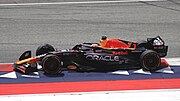List of Formula One seasons
 From Wikipedia - Reading time: 14 min
From Wikipedia - Reading time: 14 min
| Formula One |
|---|
A total of 74 World Championship seasons of Formula One (F1) have been run.[1] F1 is the highest form of open wheeled auto racing series regulated by the Fédération Internationale de l'Automobile (FIA), motorsport's world governing body.[2] The "formula" in the name alludes to a series of rules established by the FIA to which all participants and vehicles are required to conform.[2][3] The F1 World Championship season consists of a series of races, known as Grands Prix, held usually on purpose-built circuits, and in a few cases on closed city streets;[4] the most prestigious of the street circuits is the Monaco Grand Prix.[5] As of 2021[update], the sporting regulations established by the FIA's Statutes state that the minimum number of events needed to form a F1 season is 8.[6][7] The season can be declared a World Championship if F1 visits at least 3 continents in that season according to the International Sporting Code.[8] The World Championship rule can be declared invalid if the FIA grants F1 an waiver for its "long‐established use of the word 'World'."[8] Each season throughout F1 history has consisted of between 7 and 22 Grands Prix,[a][10] and the regulations are regularly amended to enable an increase of the maximum number of permitted races each year.[2][11]
The World Drivers' Championship is awarded to the most successful F1 driver over the course of the season, as determined by a points system based on Grand Prix results,[12] and has been awarded since the first F1 season in 1950.[13] The championship is the successor of the pre-war AIACR European Championship held between 1931 and 1939.[14] The World Constructors' Championship is awarded to the most successful Formula One constructor over the course of the season, as determined by a points system based on Grand Prix results.[12] The Constructors' Championship was first awarded as the International Cup for F1 Manufacturers in 1958, and its current name was adopted in 1981.[15][16] Different combinations of chassis and engine makes are considered to be different constructors for the purposes of the Championship. Constructors' Championship points are calculated by adding points scored in each race by any driver for that constructor.[12] Up until 1979, most seasons saw only the highest-scoring driver in each race for each constructor contributing points towards the Championship.[17] On only 11 occasions has the World Constructors' Champion team not contained the World Drivers' Champion for that season.[1][18]
As of the 2024 Las Vegas Grand Prix,[update] a total of 1,123 Formula One World Championship races have been held in 34 countries.[b][10][20] Over 73 seasons, there have been 34 participants from 15 different nationalities who have won the World Drivers' Championship, with Michael Schumacher and Lewis Hamilton tied for the record for the highest number of titles won with seven. Over 64 seasons, 15 teams representing 5 individual nations that have claimed the World Constructors' Championship, with Ferrari winning more titles than any other squad with 16. Seasons which were run to F1 rules prior to the inaugural World Championship season in 1950 and those that were part of each of the British Formula One Championship and the South African Formula One Championship are not included in this list.[1][18]
Seasons
[edit]| * | Season in progress |
Notes
[edit]- ^ The Indianapolis 500 was not a "Grand Prix" but was included as a round of the World Championship from 1950 to 1960.[9]
- ^ The Formula One standard was agreed upon in 1946 with the world championship formalised the following year before the first season in 1950.[19]
- ^ The 1976 Argentine Grand Prix was due to begin the 1976 Formula One season but it was cancelled as a result of economical and political unrest in Argentina.[21]
- ^ McLaren scored 218 points but were excluded from the championship because of the team's involvement in the 2007 Formula One espionage controversy. Before that, the team did not score 15 points for finishing first and fourth because one of its drivers Fernando Alonso was deemed to have delayed his teammate Lewis Hamilton enough during a pit stop to prevent him from setting a lap time in qualifying for the Hungarian Grand Prix.[22]
- ^ The 2011 Bahrain Grand Prix was due to begin the 2011 Formula One World Championship but was postponed and ultimately cancelled by local organisers as a result of the Bahraini uprising of 2011.[23]
- ^ The 2020 season was scheduled to feature 22 races before the COVID-19 pandemic forced 13 race cancellations and the addition of new events to the calendar.[24]
- ^ COVID-19 restrictions meant the 2021 season featured 22 races instead of a planned 23 with the addition of new Grands Prix and the cancellation of five planned events.[25]
- ^ Due to the 2022 Russian invasion of Ukraine and the following suspension of the Russian Grand Prix, the 2022 season featured 22 races instead of the originally planned 23 races, the FIA deciding not to replace the suspended Grand Prix.[26]
- ^ Due to continuing COVID-19 restrictions in China that forced the cancellation of the Chinese Grand Prix, the season was expected to feature 23 races instead of the originally planned 24 events, the FIA deciding not to replace the event.[27] The Emilia Romagna Grand Prix was later cancelled due to torrential rain and floods in Emilia-Romagna, further reducing the calendar to 22 races.[28]
References
[edit]- ^ a b c d "F1 Results 1950–2023". Sky Sports. Retrieved 12 September 2024.
- ^ a b c "The FIA FAQ on Formula One World Championship". Atlas F1. Archived from the original on 5 April 2001. Retrieved 28 February 2021.
- ^ Williamson, Martin. "A brief history of Formula One". ESPN. Archived from the original on 4 January 2018. Retrieved 4 January 2018.
- ^ Hughes & Tremayne 2002, pp. 82–83
- ^ Serge, Denis (23 May 2001). "Full speed ahead at Monte Carlo". Financial Times. p. 03. ProQuest 248968297. Archived from the original on 4 April 2023. Retrieved 7 December 2020 – via ProQuest.
- ^ Saward, Joe (20 March 2020). "How Coronavirus and Season Uncertainty Forced Formula 1 to Push 2021 Regulations to 2022". Autoweek. Archived from the original on 29 March 2020. Retrieved 10 February 2021.
- ^ Richards, Giles (9 April 2020). "F1 aiming to begin behind closed doors in Europe with hope for 19-race season". The Guardian. Archived from the original on 9 April 2020. Retrieved 18 February 2021.
- ^ a b Pavey, James (3 April 2020). "World championship without the 'world'? Virus delays force F1 season into uncharted territory". Fox Sports Australia. Archived from the original on 4 April 2020. Retrieved 7 December 2020.
- ^ Smith 2019, pp. 10, 76
- ^ a b c "All-Time Calendar". ChicaneF1. Archived from the original on 17 September 2020. Retrieved 7 December 2020.
- ^ Smith, Luke (2 April 2020). "How many races does F1 need to declare a season?". Motorsport.com. Archived from the original on 10 April 2020. Retrieved 16 December 2020.
- ^ a b c Budzinski, Oliver; Feddersen, Arne (March 2019). "Measuring Competitive Balance in Formula One Racing" (PDF). Ilmenau Economics Discussion Papers. 25 (121): 5, 7. ISSN 0949-3859. Archived (PDF) from the original on 7 March 2020. Retrieved 28 February 2021 – via EconStor.
- ^ White 2008, p. 12
- ^ "Formula One Series Page". Racing-Reference. Archived from the original on 15 January 2021. Retrieved 12 February 2021.
- ^ Holding, Joe (6 February 2021). "Most successful F1 teams: Which team has the most constructors' titles?". Autosport. Archived from the original on 6 February 2021. Retrieved 12 February 2021.
- ^ Diepraam, Mattijs (3 January 2008). "Poachers turned gamekeepers: how the FOCA became the new FIA: Part 4: 1981 – long live the FIA F1 World Championship". 8W. Forix. Archived from the original on 31 January 2008. Retrieved 12 February 2021.
- ^ Hayhoe 1989, p. 8
- ^ a b c Diepraam, Mattijs (3 November 2019). "European & World Champions". 8W. Archived from the original on 4 November 2020. Retrieved 18 September 2020.
- ^ Williamson, Martin. "A timeline of Formula One". ESPN. Archived from the original on 3 May 2017. Retrieved 11 February 2021.
- ^ "Circuits". StatsF1. Archived from the original on 13 February 2021. Retrieved 18 February 2021.
- ^ Henry, Alan (March 1976). "The Brazilian Grand Prix; Lauda confirms Ferrari's misery". Motor Sport. LII (3): 248. Archived from the original on 25 June 2021. Retrieved 28 February 2021.
- ^ Knutson, Dan (14 December 2007). "It was feast or famine in 2007 F1 season". ESPN. Archived from the original on 20 December 2007. Retrieved 18 November 2020.
- ^ "Bahrain F1 Grand Prix cancelled for 2011". Sportsnet. Associated Press. 10 June 2011. Archived from the original on 15 February 2021. Retrieved 12 February 2021.
- ^ Arron & Dodgins 2022, p. 44
- ^ Horton, Phillip (28 August 2021). "F1 Officially Concedes It Won't Get in 23 Races in 2021". Autoweek. Archived from the original on 28 August 2021. Retrieved 16 December 2021.
- ^ Morlidge, Matt (18 May 2022). "Formula 1 won't replace Russian GP this season, as 22-race calendar confirmed". Sky Sports. Archived from the original on 7 June 2022. Retrieved 25 July 2022.
- ^ Noble, Jonathan (17 January 2023). "F1 announces it will not replace Chinese GP in 2023". Autosport. Archived from the original on 17 January 2023. Retrieved 17 January 2023.
- ^ Baldwin, Alan (17 May 2023). Neely, Jason (ed.). "Imola F1 race called off as floods devastate region". Reuters. Archived from the original on 17 May 2023. Retrieved 17 May 2023.
Bibliography
[edit]- Hayhoe, David (1989). Kimberley Grand Prix Data Book: Formula 1 Racing Facts and Figures 1950 to Date. Sparkford, England: Haynes Publishing. ISBN 0-946132-63-1 – via Open Library.
- Hughes, Mark; Tremayne, David (2002). The Concise Encyclopedia of Formula 1. Bath, England: Parragon. ISBN 0-75258-766-8 – via Open Library.
- White, John (2008) [2007]. The Formula One Miscellany (Second ed.). London, England: Carlton Books. ISBN 978-1-84732-112-1 – via Open Library.
- Smith, Roger (2019). Formula 1 All The Races: The First 1000. Poundbury, England: Veloce Publishing. ISBN 978-1-787115-66-8.
- Arron, Simon; Dodgins, Tony (2022). Formula One: The Pinnacle: The Pivotal Events That Made Formula 1 Motorsport's Greatest Series. Brighton, England: Ivy Press. ISBN 978-0-7112-7420-4.
External links
[edit] Media related to Formula One seasons at Wikimedia Commons
Media related to Formula One seasons at Wikimedia Commons- Formula One official website Archived 20 March 2008 at the Wayback Machine
- FIA official website Archived 13 August 2022 at the Wayback Machine
 KSF
KSF
